By Vladimir Brezina
Anyone paddling a kayak very soon discovers the power of wind. Even a modest breeze pushes the kayak briskly along. A headwind cuts progress right down. And, once the difficulties of controlling the kayak in wind and waves are mastered, a good tailwind makes the miles fly by.
Since expedition kayaking is all about using the available natural forces to complete the journey in the most economical manner, why not use the power of the wind most effectively, by putting up a sail? Even purists who consider this cheating will sit up straighter in a tailwind, or hold up a jacket, or even open an umbrella. Why then not a real sail?
Kayak sailing has caught on! There is now out there a huge variety of kayak sail rigs, both home-made and commercially produced, ranging from simple sails that are not much more than umbrellas to serious rigs. Most of the simpler sails are downwind sails, offering little or no cross-wind, let alone upwind, performance. True upwind performance, comparable to that of a small sailboat, takes a true aerodynamically efficient upwind sail, and usually outriggers or stabilizers of some kind that allow a much larger sail to be mounted and used aggressively without fear of capsize. Some of the most powerful and elegant such rigs are made by Balogh Sail Designs.
How I came to Balogh Sail Designs
I was introduced to kayak sailing in 2002, when I and Mark Starr sailed a double kayak 100 nautical miles along the New England coast, from Stonington, Connecticut, clear across Rhode Island, through Vineyard Sound and Nantucket Sound, to Chatham, Massachusetts. (I’ve posted the story in a separate post.) It was a memorable trip. I was hooked!
That kayak had a Balogh Batwing sail with BOSS (Balogh Outrigger Stabilizing System) outriggers, and when I got back, I wanted a rig just like it. But my kayaks are folding kayaks, and when I contacted Mark Balogh, he told me that he was still experimenting with mounting his sail rigs on folding kayaks. Mine would be one of the first, and it might take some time…
It took the best part of three years—because Mark Balogh was a perfectionist, did everything himself, and was overwhelmed with orders. He was notorious for absurdly late deliveries, which probably contributed to the fact that Balogh Sail Designs now has a new owner.
Still, his sail rigs were highly thought of and sought after, and mine, once I actually received it in early 2007, was beautiful in design and workmanship. The design had many sophisticated features for high performance, yet was strong and simple, clearly honed by a long evolution and experience. And Mark used only the best materials and highest-quality marine-grade fittings. (This was another source of production delays: when the best part was not available, production stopped until it was.) Of course, the rig was not cheap. In short, the Cadillac of kayak sailing rigs :-)
My Balogh sail rig
With the options that I selected, my rig, slightly customized for mounting on my Feathercraft K1 Expedition folding kayak, consists of
- a 13-foot, 4-section anodized aluminum mast
- a 32-square foot Batwing Expedition sail made of heavy-duty fabric with three tapered fiberglass battens for a precise airfoil shape and two “zippy” reefing points that allow different sections of the sail to be zipped together to reduce the sail area to 28, 24, and 20 square feet
- an anodized aluminum Wingbone compression strut that acts as a boom for the sail and allows efficient sheeting of the sail from a wide range of sheeting point locations
- the BOSS system, consisting of a central cross-tube that attaches both to the mast and by four struts that insert into reinforced fittings in the skin ultimately to the internal frame of the kayak, two akas that extend the cross-tube outward (all anodized aluminum), and two inflatable plastic laminate amas
- a fiberglass leeboard
- a large rudder (similar to this one) controlled by cross-bar foot pedals made by Mark to replace the standard Feathercraft sliding footpegs
- assorted stainless steel and plastic fittings (Harken cam cleats, blocks, shackles) and lines.
The two components that make the Balogh rig special, and of which Balogh Sail Designs is justifiably proud, are the Batwing sail, described thus:
The prominent feature of the BSD BATWING™ is the hanglider inspired airfoil. Inherently low parasitic and induced drag components are particularly appropriate rig characteristics for the limited stability of narrow, small sailing craft. The BATWING™’s efficiency and low center of effort provide superior performance on all points of sail.
and the BOSS system:
Using light weight aluminum tubes for the akas and modern laminates to make inflatable amas we invented the BOSS™ outrigger system especially for sailing kayaks. Among the challenges were to make a sturdy inflatable ama shape that could compete hydrodynamically with the long thin traditional ama shapes. During development, we came up with a design for mounting the amas to the akas that is completely unique and covered by two U.S. patents. The patents cover a method of mounting that allows automatic and manual adjustments of the ama to alter its hydrodynamic characteristics to suit specific conditions. In short, the suspension system allows the ama to adjust its shape in reaction to the water.
Furthermore,
we also felt that the ability to convert from a kayak to a sailing kayak and back, at any time, on the water or on the beach was absolutely critical if our boats were to maintain their function as kayaks.
Indeed, as I have personally verified at least under calm conditions, apart from the cross-bar that is semi-permanently mounted, the entire rig—the akas, amas, mast, and sail—can be assembled and disassembled while on the water and stored either inside the kayak or at least on deck. The longest section of the rig is 47 inches long, the whole rig weighs 22 pounds, and it fits into a large canvas sail bag. A perfect complement for a folding kayak on its travels!
Early on, I had to decide whether to mount the rig forward or aft of the cockpit. Given the fitful winds of the New York summer, I had a strong suspicion that I would often find myself both sailing and paddling. (I was right.) I therefore inclined toward the somewhat less usual aft mounting because I thought that it would interfere less with my paddle stroke. Mark Balogh’s take:
There are always some tradeoffs in choosing a rig location. My personal feeling is that mounting the rig aft to gain paddle clearance is not the best strategy. The problem is that to gain real paddle clearance you have to move the rig further aft of the cockpit than might be best for sailing. To gain the paddle clearance you tend to sacrifice handling performance.
[But that said,] I would say that for best sailing performance there is little difference between the forward and aft mounted rigs. If either is located for best sailing there will be paddle cross tube interference just on different ends of the stroke. My reason for choosing aft rig on my own boat would be that like the clear view forward and I think some boats may sail as well or better with an aft rig. The downside is that you really have to develop a good feel for sail trim and even with good technique, handling the halyard and downhaul can require more physical flexibility. Also boats with aft mounted rigs usually demand more from the rudder system.
In the end, I decided on the aft mount, and I’ve been happy with it. As I expected, it interferes little with my paddle stroke, which is, or should be, a high-angle stroke far forward—indeed, when it does occur, the clatter of the paddle against the cross-bar behind me is a useful wake-up call (sometimes literally) that my form is slipping. With the aft mount, the view forward is unobstructed. The aft mount avoids the awkwardness of having the mast, if mounted forward, between my legs and furthermore interfering with the loading of the bow of the kayak, which, given the small bow hatch of the Feathercraft K1, must be done through the cockpit. Against these advantages of the aft mount, there is the need to sail largely by feel. But I soon learned to do that, and for reefing and other more extensive adjustments to the rig it is easy, with the stability provided by the outriggers, to completely turn around in the cockpit (see photo below). The large rudder provides more than sufficient steering authority.
Some of my kayak sailing trips
From my base at Pier 40 on the West Side of Manhattan, I’ve sailed in all directions—north up the Hudson River, south into the Lower Bay of New York Harbor, and east into Long Island Sound.
Here is a photo from 2007, from a series taken automatically every five minutes with a waterproof camera attached to the end of an aka. To beat the New York summer heat, this was a night sail, leaving Manhattan before sunset and returning before dawn. In an earlier post I’ve already posted a slideshow from another such sail that same summer; the individual photos are here.
A memorable sail, in August 2007, was from Manhattan out into Western Long Island Sound and back, altogether 110 nautical miles in two days. For that trip I attached the camera to the top of the mast; the series of photos is here. The first day was uneventful: except in brief thunderstorms, the wind was weak and variable, and I paddled more than I sailed.
But that night, as I slept on the beach at Lloyds Neck on the north shore of Long Island, a cold front came through. I woke up to an autumnally blue sky and a cold 20- to 25-knot wind out of the northwest. In front of me, Long Island Sound was covered in whitecaps. I pushed off the beach and set a course across the wind. Even with two reefs in the sail, the boat picked up speed and soon was streaking through the water at 10 to 12 knots, bouncing over the 3-foot waves. The next few hours were eventful.

Second day, 3:40 p.m. The wind is moderating, so I am taking a reef out of the sail. Notice how, with the stability provided by the outriggers, I can climb out of the cockpit and turn completely around to attend to the rig.
How does such a sailing kayak perform?
Given steady wind of 10 knots or more, the boat just flies across the wind on a beam reach, its best point of sail. Of course, being so close to the water and waves exaggerates the sense of speed—that’s half the fun, getting a thrilling ride at speeds of just a few knots—but by my GPS I’ve attained speeds of 10-12 knots and more. Higher speeds still might be achieved with the same rig mounted on a slimmer kayak—the Feathercraft K1, 16.5 feet long and 25 inches wide, has a fineness ratio of only 7.9.
Sailing upwind, performance is good, too. However, especially in light winds it can be difficult to sail less than about 50 degrees off the wind. Then I usually paddle as well. Paddling keeps the speed up and allows the boat to sail noticeably closer to the wind, presumably by increasing the apparent wind.
A related problem is that coming about through the eye of the wind can be difficult to complete. The boat does not have enough momentum to drag the downwind ama, which digs into the water, through the turn. I believe that this is a problem with light multihulls generally. Again, paddling helps complete the turn.
Running downwind, especially in light winds, the boat can feel a bit sluggish. I get impatient and paddle under these circumstances too… A head sail of some kind might help. I notice that Feathercraft, which now also sells a rig much like Balogh’s (although less elegant in detail), offers a jib as well as a spinnaker. Balogh Sail Designs apparently does not.

Sailing AND paddling. The top batten, which is short and stiff, often remains bent the wrong way after a tack without (minor) intervention. Notice also the bend of the mast.
Clearly, sailing a kayak takes a lot of paddling :-) Fortunately, with the aft-mounted rig, I find that I can paddle the fully rigged boat almost as fast as I can the bare kayak. The handling characteristics are very different, however. With the widely spaced outriggers, the boat is massively stable. (At first I instinctively continued to try to lean the boat into waves; I soon learned that this was unnecessary and indeed ineffective.) I can take a nap, get out of the cockpit and turn around, stand up and stretch.
This opens up new possibilities for long kayak expeditions. It’s not that sailing is all that much faster. With weak, shifting, contrary winds, sailing might take just as long as paddling to a distant destination. But there is much to be said for knowing that your boat will carry on steadily whether you paddle or not, while you watch the sea, eat, sleep, keep warm—simply live, which at times may take all your energy—for days if need be.
Balogh Sail Designs today
Since 2009, Balogh Sail Designs has been owned by David Valverde, who clearly has injected new energy into the company. Various Batwing / BOSS rig configurations for folding kayaks, hardshell kayaks, and canoes are available, as well as several other sail types.
Best of all, Balogh Sail Designs is now based in my neighborhood, on the Upper East Side of Manhattan. I’ll have to pay them a visit soon!

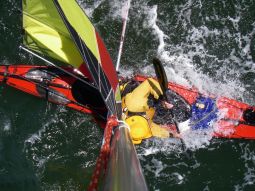

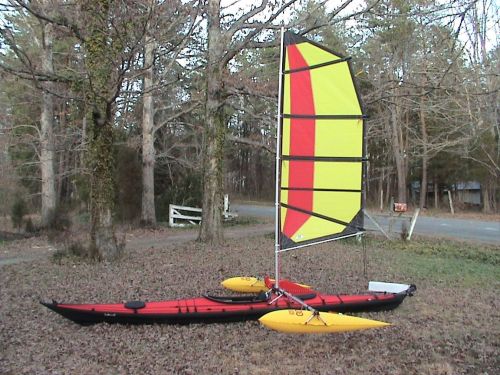
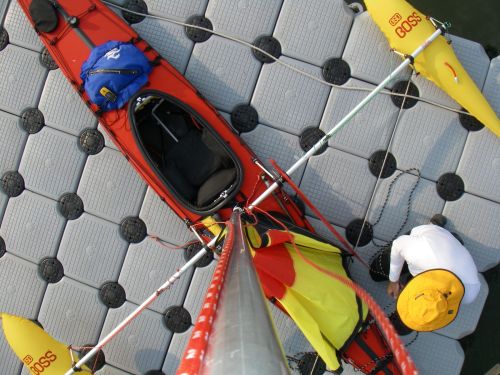
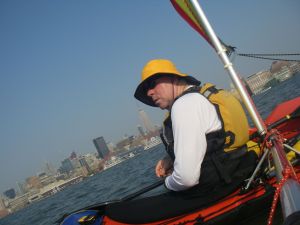
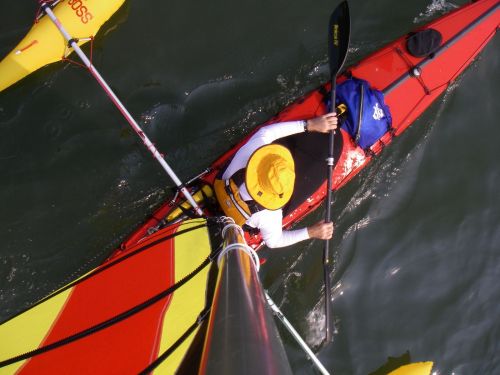







Pingback: CK Products 3-D Sail Boat and 3-D Motor Boat Chocolate Mold Reviews | Boating
To see photos of the kayaks in addition to to get far more whitewater inflatable kayak evaluations visit http://www.InflatableKayakWorld.com wherever there are this kind of plus much more …buy kayaks
LikeLike
Great piece
LikeLike
Thanks, Tom—I am glad it was useful!
LikeLike
Pingback: Weekly Photo Challenge: From Above | Wind Against Current
Pingback: Travel Theme: Tilted | Wind Against Current
Pingback: My Kayak Photography | Wind Against Current
Pingback: Weekly Photo Challenge: Zigzag | Wind Against Current
Oh my gosh…I am thrilled that my local has ‘torchlight kayaking’ (kayaking at night in the bayou–we’re not leaving there any time soon), and now you show sail kayaking. I have very much to learn….
LikeLike
And it goes on and on. After kayak sailing, there is kayak fishing… :-)
LikeLike
Pingback: Self | Wind Against Current
I too, own a Feathercraft K1, and have the exact same rig mounted; but I put my mast in the rear hatch. That necessitated a much bigger sailing-type rudder; which Dave Valverde helped me to build. This system is simply the FINEST sail rig out there ! If you are considering one, GO FOR IT ! You won’t be disappointed ! You get what you pay for, and these rigs are the finest made !
Andrew Klinzmann Beaumont, Alberta, Canada
LikeLike
Hi Andrew,
Unfortunately Vlad is no longer with us (and sadly, the same is true for Feathercraft). I’m posting your comment so others can see, and perhaps learn. But Vlad no longer needs kayak sails, alas….
LikeLike
So sorry to hear of that.
As to Feathercraft, yes, Doug Simpson closed his doors. But he still maintains a small shop in BC, Canada. A limited selection of parts can still be purchased from him, and he can manufacture certain items as well. But no repairs or modifications are available anymore. Direct any inquiries to info@feathercraft.com….
LikeLiked by 1 person
Well, that’s good news for Feathercraft afficionados! Thanks for the update!
LikeLike